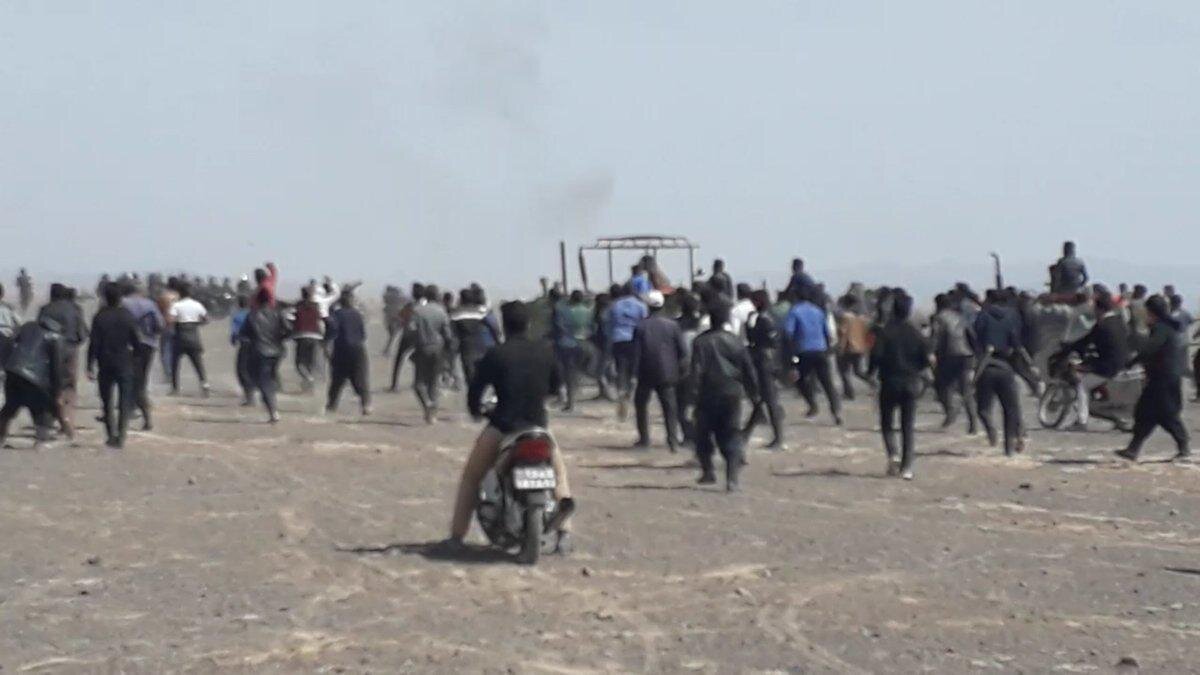Group of Thought: Doctor Abbas Hatami Member of the Founding Board of Intellectual Development and Faculty Member of Isfahan University, in the following analytical note on the channel “Development Scout” Published, the emerging and relatively exceptional phenomenon of water uprisings in eastern Isfahan has been in the last two decades. By rejecting the common view of the absence of peasant movements in modern Iranian history, the author tries to respond to why and how these uprisings and their tendency to be formed and expanded. The main axis of the author’s analysis first includes A sense of deprivation and rejection Is. Accordingly Farmers in eastern Isfahan, who not only face water shortages, but also have a deep sense of injustice in the allocation of water resources and rejection of the water governance system. They feel that they have been ignored in prioritization and have been victimized by the Coalition of Government and Industries. Hatami. Also on another axis on The emergence of class consciousnessEmphasizes. In his view, cyberspace has played an important role in informing and mobilizing farmers. Through this space, they have obtained information on unfair allocation of water and have become class conscious from “class in self” to “class for their own” with class consciousness. This university professor in another axis The inaction and inaction of the state In the face of Zayandehrood’s water crisis, it has been effective in creating anger and exacerbating farmers, and believes that the failure of the farmers’ previous peaceful actions has played a role. Hence the author’s point of view Violent reaction as a mandatory actionBreaking the water pipes to Yazd by farmers is not merely an active choice, but a reaction to the inaction of the government and the impasse of their lives. Hatami. Also on The spread of the social foundations of the uprising that Recruiting power from other social classes, such as environmental supporters and health, believes that the movement has the potential to become a more inclusive social movement by expanding the subsidence.The bond of death and the life of the uprising with the revivalAnother is the author’s analytical axis. Hatami concludes that the survival of this peasant uprising is directly tied to the revitalization of the Zayandehrood River, and one cannot expect the silence of this social flow until Zayandehrood is revived. This exceptional link, like the emergence of this uprising, is unprecedented in modern Iranian history. In short, it wants to say that the peasant uprising of the eastern Isfahan peasant is rooted in the deep sense of deprivation, class awareness of information access, and the government’s passivity in resolving the water crisis. This rise is expanding potential and its fate depends on the revival of the Zayandehrood River. The author advises the government to take this exceptional phenomenon seriously. This is the following:
****
Iran is generally known for the occurrence of a variety of uprisings and social uprisings. As the uprisings of the workers, student, women, traditional middle classes, and new middle middle classes can be found in the last hundred years. But there is a common view among the social science researchers that, unlike other class movements, peasant movements have been largely absent in Iran. However, it seems that in the last two decades, an almost exceptional phenomenon has been happening in the central Iranian plateau. This exceptional phenomenon is the emergence of continuous water uprisings in the context of a more or less peasant movement that farmers in eastern Isfahan were in the center of gravity. This uprising, which began in the east of East Isfahan in the years 6, has now become an almost coherent and partial peasant uprising. This note attempts to answer the question of why and how the peasant rises and uprisings have expanded and expanded in this part of Iran in recent decades, and in some cases the path of violence?
A sense of deprivation and rejection
The first factor Important in the emergence of the peasant uprising is the feeling of deprivation, injustice and rejection. In the literature of the revolution and the political mobilization, the sense of deprivation and unfairness of existing relations has always been considered one of the main reasons for the uprising, revolt and even revolution. As far as east of Isfahan, it seems that the feeling of deprivation has played a key role in the emergence of peasant uprisings in the area. As common among Eastern farmers, they have been “thirsty for water thirst for water” rather than “thirsty water”.
This feeling of injustice and deprivation of farmers in eastern Isfahan has been aroused at least two. The emergence of this deprivation was on the one hand due to the allocation of significant volumes of water for the top and the low allocation or lack of water downstream. The farmers’ asking here is that if there is no water why there is upstairs but not downstream for the east. Why is it not for the industry upstairs, but for farming. This policy of one roof and two air is the main cause of the emergence of deprivation and injustice that is now widespread among Eastern farmers.
The second issue The feeling of marginalization and rejection of farmers in the water governance system and the relations of the power governing it. For example, in the field of water governance, drinking water supply in Iran has always been a matter of sovereignty and security in a sense, and the power of the state has always been a guarantor to supply it. Industrial water supply is also generally guaranteed by the powerful lobby of industries and their high economic power, though less guaranteed. But such a guarantee was generally not only for the agricultural sector, but the idea of Eastern farmers, which part of Yazd’s transitional water covered in drinking, is spent on non -drinking uses, including the industry, has acted on a delegation of a government -industry coalition against farmers.
Accordingly, farmers have come to realize that they have been abandoned or even abandoned in the water relations, and they have seen themselves as forgotten by those of water governance. Part of the peaceful and violent actions of the farmers can be analyzed from this point of view, the rejection of the circle of water and rebellion against this rejection. In this situation, farmers have realized that the rebellion against these unfair relationships requires collective action and that the East needs to do so.
The emergence of class consciousness
The second factor was the emergence of class consciousness. In fact, what has led to a social sense of deprivation and rejection of Eastern farmers has been the emergence of this farmers’ class awareness. In this sense, the emergence of social was the feeling of crop deprivation, and the emergence of the farmers’ class consciousness, much of which has been obtained in the context of cyberspace. Through cyberspace, farmers have obtained significant information on the situation of unfair water allocation, and their sense of deprivation has been aroused and socialized.

March; Law enforcement forces from destroying water transfer to Yazd in Varzaneh in eastern Isfahan
According to Marx Word, cyberspace has made the farmers of eastern Isfahan become a “self” class “for” self for “and qualified class awareness. The cyberspace has also made it possible for them to help, network, call for gatherings and, in general, to mobilize more resources. For this reason, perhaps the most specific distinction between farmers before and after the revolution was this form of widespread awareness and mobilization of resources through cyberspace. On this basis, it can even be claimed that without access to cyberspace, the peasant uprising in eastern Isfahan probably would not have appeared so broad.
Disobedience
In addition to its sense of deprivation and social incidence of raising class consciousness, the third most effective factor in the emergence of this movement was the passivity and implementation of political construction in the face of the water crisis in the Zayandehrud Basin. It is true that the collective actions of the farmers in East Isfahan have recently been taken into consideration, but historically the origins of the protest of the farmers of eastern Isfahan can be followed for years. As the first of these protests began in a limited form of Varzaneh in eastern Isfahan and at the end of the decade. In this sense, at least about 5 years have passed since the protests. Although over the past five years, the political system’s response to farmers’ protests has been a combination of passivity, violence, and compromise, the government’s passivity in resolving the water crisis has always been over the past twenty -five years.
On the other hand, farmers in East Isfahan have tested a variety of peaceful ways to solve the water crisis from writing petitions to installing complaining placards, but have not achieved any results. For a long time, the failure of farmers’ peaceful actions on the one hand and the passive government on the other hand has fueled a kind of anger among farmers who have occasionally refused and appeared in the form of naked social anger. In this sense, the obvious emergence of this social anger in the forms of breaking the water pipe to Yazd has been on the second coin of the government’s passive coin in resolving the water crisis. In other words, farmers have not revolted, they have been revolted because of the government’s passion in resolving the water crisis. For this reason, the breakdown of the water pipe to Yazd should not be considered an active choice or action by Eastern farmers, but rather a reaction to the government’s inaction. Here, both Eastern farmers and Yazidis have been both victims of the government in resolving the Zayandeh River water crisis.
More precisely, the path of resorting to violence has not been selected by Eastern farmers, but for which they have been selected. Although this analysis does not, however, does not in accordance with the violent actions of the farmers, it is not only possible to see farmers’ actions and the cause of the emergence of these actions. So the unjust analysis that says that the only art of Eastern farmers is to rotate themselves in the air does not realize that the farmers have been rotating for a long time before turning. As the first half of their peasant uprising was essentially based on peaceful movements. It does not consider how the entire state of water in Iran has stopped the tractor wheels of farmers from rotating and replacing their shovels instead? He does not realize that if Bailey is rotated, it is because the wheel of life and life of the farmers would no longer rotate. It is not realized that these are bad governments in the field of water that have caused the shovels to rotate in the air instead of shovels.
Final Tip
It seems that what is happening in the east of Isfahan cannot be reduced to rotate the shovel in the air or break the water pipe. On the contrary, a peasant uprising in eastern Isfahan seems to be forming and expanding. As this uprising is gradually expanding its social foundations among farmers, it also strives to help other social classes. For example, this uprising is now being recovered from the middle classes such as supporters and environmentalists and health fields. Moreover, with the expansion of the subsidence of the land as a public issue that has taken place as a result of the drying up of the Zayandehrood Basin, the social foundations of the movement are expected to be strengthened even among other urban social classes. This shows to what extent this uprising has the potential to become a widespread social uprising within it, and to how much it is far from reality.
For this reason, it is likely that the peasant uprising can gradually find even wider social foundations until the Zayandehrood River. In other words, until the Zayandeh river does not live, the death and silence of this peasant uprising cannot be talked about. This means that in the East, there is a strong bond between revitalizing the natural flow of the river and the death of the peasant uprising. This method of link between death and life in eastern Isfahan reflects an exceptional link; Just like the emergence of the peasant rise in eastern Isfahan, which is an exception in modern Iranian history. The recommendation of this note to the sovereignty is not to underestimate this exception in the central plateau and the necessity of revitalizing the river.
*Abbas Hatami: Member of the Founding Board of Intellectual Development
1
منبع: www.khabaronline.ir



